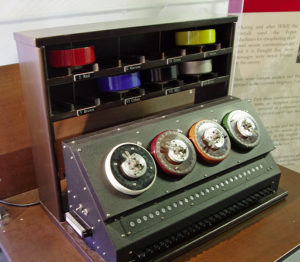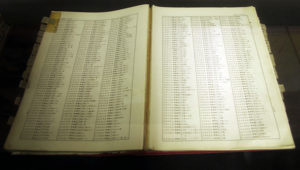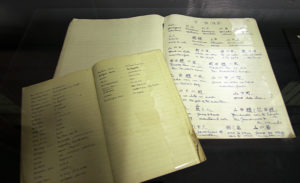Bletchley Park covers a huge area with different buildings carrying out different tasks. There was no communication between the buildings and personnel didn’t know what went on in another building. The keep the review manageable, I have broken it up into different sections for the different buildings. This just covers Block B.
Block B is the large reinforced concrete building behind the Visitor Centre in Block C. It was built to house the sections handling Enigma ciphers from the Italians, French and other European nations. Its work was later extended to include Japanese cryptographers.
Now it houses the museum with information on how the Enigma code was broken. There are examples of Enigma machines as well as a reconstructed Bombe.
THE ENIGMA MACHINE
The Germans had been using Enigma machines from the 1920s to send encrypted messages. The original machines were fairly simple and used to keep commercial and financial data secure. Later the machines were adopted for use by the German military who introduced additional security features and the codes were regarded as unbreakable. The army, navy, air force, gestapo, and diplomats used slightly different forms of machines.
They look like a portable typewriter and used batteries to run. Each operator had their own machine. They were popular as they were easy to transport, could be used in the field without the need for land lines and were simple to use.
Three wheels inside the machine are set according to the monthly code sheet. No wheel order is repeated in the month. When a key is pressed the wheels turn and the new letter appears lit up on a panel behind the keyboard. This is then written down by the operator who then moves on to the next letter. The wheels move again and a new letter is illuminated. Once the message is complete, the letters are broken into groups of five that are turned into morse code before being transmitted. The recipient used the code sheet to set his machine. When the encoded letters are entered, the original letter is lit up and written down.
The combination of wheels and starting points for each wheel means there are 158 million, million, million possible solutions.
BREAKING THE CODE
The early work was done by the Poles. As German military power increased in the 1920s, Poland felt increasingly threatened and vulnerable. They were monitoring all German radio messages. In 1928 they began to intercept messages using a new cipher which they eventually identified as coming from an Enigma machine. Initially the cipher was only changed every few months. Once war began, ciphers were changed every 24 hours. They managed to acquire a commercial machine which was a lot less complex than models used during the war. They tried a mathematical approach to breaking the secret of the code using the repeating message key at the start of a transmission.
In the early 1930s, the French also began work, using information from a German spy and began collaborating with the Poles at the outbreak of war. With the French information, Marian Rejewski was able to deduce the internal wiring of the Enigma machine. This enabled Polish cryptographers to build replicas of the German Enigma machine which could them be used to decipher radio messages once the Enigma configuration and message settings had been worked out.
Henryk Zygalski realised the same enciphered letter occurred in either the 1st and 4th, or 2nd and 5th, or 3rd and 6th positions in the enciphered message settings, depending on the wheel order. If there was enough data it would be possible to find the unique configuration. This could be done using punched sheets and resulted in the production of a simple Bombe machine.
By 1938, the Poles were successfully reading 75% of the German transmissions without the Germans realising. The Germans then added another two wheels to the Enigma machine, so the operator had to choose three of the five to enter into the machine. This increased security but also the amount of effort and time needed to find the key.
With the invasion of Poland and the fall of France, the Polish and French crytographers gave the British copies of all their work.
The British were aware of the Enigma machine and had developed their own version which became the Typex machine. They had not yet realised the importance of mathematics rather than linguistics in breaking the code. With the information from the Poles and French, they now began to recruit mathematicians to the team. Peter Twinn was the first, followed by Alan Turing, quickly followed by Gordon Welchman.
Turing realised it was possible to identify standard message formats which could be used as a Crib to allow parts of the message to be guessed. This could be used to reduce the number of variables for the Bombe. But it was still very much trial and error to discover the correct sequence of wheels and starting points.
The Royal Navy captured the German U-boat U-110 on May 9, 1941 in the North Atlantic. The U-Boat was badly damaged and its crew surrendered. Three British seamen managed to board the U-Boat just before it sank, recovering an Enigma machine, its cipher keys, and code books. The material was sent to Bletchley Park and the codes allowed messages on U-Boat movements to be read quickly for several months. This information also helped them to create Cribs which could be used once the codes ran out.
THE BOMBE MACHINE
The Enigma code has 158 million, million, million possible solutions. If a suitable Crib can be found, this reduces the number of possibilities down to one million. The Bombe designed by Alan Turing and Gordon Welchman was a complex electrical circuit used to carry out a systematic search to find those combinations of Enigma wheels and starting positions that generate the correct pattern of letter pairings from the Crib. Once a logical sequence was detected, the machine stopped. Once this information has been checked and verified, the rest of the message can be deciphered quickly.
Bletchley Park had 200 Bombes by the end of the war. Unfortunately all of these were broken up and destroyed. A replica Bombe has been built and this can be seen in action in Block B. There are information panels explaining how this was rebuilt and there is also the small test model which was made to confirm it would work.
The Bombe machine is run at different times during the day and there is a very detailed explanation of how it worked. Even after listening and reading all the information panels, my maths isn’t up to understanding the details.
The back contains the mechanisms which control the wheels on the front of the machine. There are over 12 miles of wires inside the machine. Using the Crib, an electric circuit could be plugged up on the back of the machine. When turned on, the banks of wheels on the front rotate to find all the settings that could correctly encipher the letters of the Crib to give the corresponding letters in the original message. The Bombe would stop when a possible setting was found.
The key codes were then sent to the checking machines to confirm they were accurate. If they were not, the operators would run the test again until the correct code was identified.
Once the correct setting for the day is established, the rest of the messages would then be deciphered and translated to confirm it made sense. Only then would the rest of the corresponding batch be deciphered using a Typex machine which was a modified Enigma machine which was modified for this purpose.
The translated messages were sent to assessors who were intelligence officers and could evaluate the importance of each before sending them onto Government officials or senior military personnel. These were sent by dispatch rider or dedicated telephone line.
There is more information about the process in “Huts 6 and 3.”:http://www.silvertraveladvisor.com/review/attraction/169752-review-bletchley-park Block B also has information panels explaining how Bletchley Park was able to send out misinformation to the Germans about the D Day landings.
BREAKING THE JAPANESE CODE
As well as breaking the German Enigma codes, Bletchley Park was also responsible for breaking the Japanese codes and ciphers and there is information about his in Block B. Japan emerged from World War 1 as the third largest naval power behind the USA and Britain. It was an important target for code breakers in the 1920s and 1930s. The Japanese used a variety of machines to encode messages. The first machine to be broken was that of the Japanese Military Attache in 1934. Other machine followed later, known by colour names, red, purple and coral.
Morse code was used to send messages along telegraph wires, but this presented major problems for the Japanese whose written language was based on picture symbols with around 70 phonic sounds. The Japanese created their own Morse code which covered all the Japanese sounds as well as the 26 Roman letters. They made extensive use of code books for military and naval codes. They also had German Enigma machines, known as Tirpitz, which they could use.
A special language school was set up in Bedford to train linguists to work as code breakers. Special vocabulary books and colloquial language books were designed for use by the linguists. There are also examples of Japanese dictionaries on display, along with examples of Index cards compiled at Bletchley Park with information on Japanese aircraft carriers, and submarines sunk.
There is more information and a lot more pictures “here.”:http://wasleys.org.uk/eleanor/presocialhistory/socialhistory/social/social/bletchley_park/index.html










